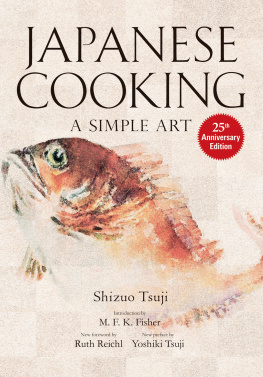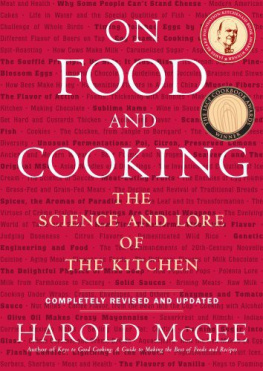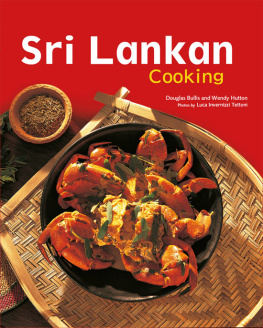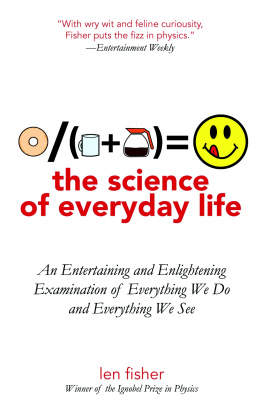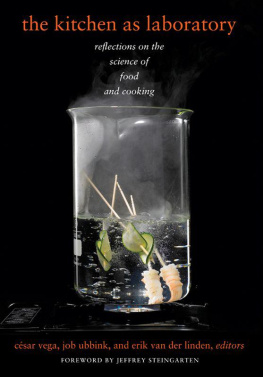TABLE OF CONTENTS
Chapter 1:
Chapter 2:
Chapter 3:
Chapter 4:
Chapter 5:
Chapter 6:
Chapter 7:
Chapter 8:
Chapter 9:
Chapter 10:
INTRODUCTION
This book is based on, and meant to serve as a companion to, the Harvard course Science and Cooking: from Haute Cuisine to Soft Matter Science . It should also be a useful resource for other courses and initiatives aiming to teach physics and chemistry through food and cooking.
In 2008 Ferran Adri, chef of the famed restaurant, El Bulli , and known for his unique and highly innovative approach to cooking, came to give a talk at Harvard University. The interest in the talk was tremendous with more than a thousand people trying to get in. This occurred around the same time that Harvard was remodeling its general education requirements for undergraduates, the purpose of which are to connect in an explicit way what students learn at Harvard to life beyond Harvard. Food and cooking is, of course, a part of everyones every day life, both while in college and beyond. What we do in the kitchen in strongly rooted in science. Moreover, when cutting edge chefs create novel dishes, they too exploit basic scientific principles.
From this confluence of events and ideas, Science and Cooking was born. The first on campus course was launched in 2010, a collaboration between Harvard and Ferran Adris El Bulli Foundation . Every week features a scientific theme, illustrated by visiting, world-renowned chefs explaining the remarkable creations from their kitchens, and explained in scientific terms by the course staff. The course also featured a lab, where recipes such as molten chocolate cake or aioli were used to explain the scientific principles of heat transfer or emulsions.
This approach to physics and chemistry education appeared to resonate with and motivate a broad audience more than 700 students tried to get into the course the first year it was offered, and the accompanying weekly lecture to the public continued to draw large crowds with lines forming hours ahead.
The interest led us, in 2013, to embark on the adventure of creating an online class available to a wider, international audience on EdX. We both wanted to share the material that was developed in the Harvard course with a wider audience, and also hoped that developing the material would allow us to improve the on-campus college course in a number of ways. One of the challenges of the course had always been that there was often far more science in the chefs creations than could possibly be addressed and explained in the limited time we had in class. In addition, like any course covering novel material, there was no textbook available that explained the science we covered in depth. The online course allowed us to address both of these concerns. By creating video materials of both basic and advanced topics, the curriculum could be modeled to students with varying science preparation. Similarly, the creation of the online videos could play the role of an online textbook.
This Companion is a direct product of the online course creation process. As part of it, we developed graphics and short videos illustrating key concepts. Additionally, in the process of producing subtitles, we generated word for word transcripts of all videos. In this Companion, the transcripts have been used as a rough draft for each chapter, which have then been heavily edited and augmented with the graphics and short videos. Thus, the order and content of the chapters and sub-chapters closely follow how the concepts would ordinarily be explained in an on-campus lecture or online video. The book contains the scientific information only, whereas in the complete course, the science is interspersed with culinary segments by the visiting chefs. It is our hope that this book is a helpful supplement to students taking the course, either on campus or online.
ACKNOWLEDGMENTS
The list of people who have, in a multitude of ways, contributed to what ultimately led to the production of this work is very long.
We would like to thank everyone who was involved in the early development of the college class: most importantly our partner Ferran Adri, and his foundation, run by Pere Castells, who freely shared their wisdom, knowledge, and excitement about the subject; Jos Andrs, whose energy for the course seemed unbounded, and has dedicated much time to its development. The first year we co-taught the course with two postdoctoral fellows, Amy Rowat and Otger Campas, both of whom were indispensable. The head teaching fellow during the first year of the course, Naveen Sinha, was as sleep deprived as the rest of us; and we were also assisted by the tireless and amazing Christina Andjar with all things organizational, as well as the demo guru Daniel Rosenberg.
Stephanie Kenen of the General Education office at Harvard encouraged us from the very beginning, and gave us important critical feedback at exactly the right times, with tremendous grace. We also thank Anne Marie Calareso, Kristina Barrett, and Karen Galvez from the General Education office.
We are deeply grateful to the visiting chefs and culinary experts who have taken time out of their busy schedules to come and talk to us and the students over the last five years. First, a special thank you to Harold McGee whose infinite knowledge continues to inspire us, and whose yearly opening lecture and treatise On Food and Cooking are in every way integral to the course. Further, we extend thanks to Grant Achatz, Jody Adams, Ferran Adri, Jos Andrs, Dave Arnold, Dan Barber, Jack Bishop, Martin Breslin, Pere Castells, David Chang, Joanne Chang, Dominique Crenn, Wylie Dufresne, Carles Gaig, Daniel Humm, Nandu Jubany, Mark Ladner, Harold McGee, Ramon Morat, Nathan Myhrvold, Pere Planagum, Fina Puigdevall, Joan and Jordi Roca, Enric Rovira, Carme Ruscalleda, Raul Balam Ruscalleda, Ted Russin, Dan Souza, Carles Tejedor, Christina Tosi, Bill Yosses.
The production of the online course was a whirlwind adventure that we feel grateful to have shared with the amazing team at HarvardX: our editors Matthew Thomas and Amanda Justice, Ana Trandafir, Heather Sternshein, Marlon Kuzmick, Annie Valva, Samantha Earp, Rob Lue, and the rest of the HX team. We are also grateful to Teppo Jouttenus, Krister Svensson, Doug Pietrzak, and the rest of the EdX team.
A special thank you to the dedicated TFs who helped with the production and execution of the first version of the online course in the Fall of 2013: Mary Wahl, Aileen Li, Helen Wu, Sorell Massenburg, Kaitlin Sandor, Tim Roth, Steve Klosterman, Greg Kestin, Emily Redstone, and Denise Alfonso.
Thank you also to graphic designers Geoff Kornfeld and Vera Baranova who created the graphics for the online class and this book; to the graphic design team at Harvard Public Affairs & Communications: Melissa Axelrod, Judy Blomquist, and Nicole Seferian; to Amanda Justice for the design of a gorgeous cover page; to Ron Bilodeau for the e-book conversion.
Lastly, we thank the General Education program at Harvard, the Harvard School of Engineering and Applied Sciences, and MRSEC for support and funding.
TABLE OF CONTENTS: 1
CHAPTER
1.1 The Components of Food
If we want to think scientifically about cooking, we have to start by thinking a little bit about what food is made of. After all, it is the constituents of food that will be the major players in this adventure that we are about to launch ourselves on.
To find the constituents of food, you can go and examine any food label in your pantry and see what it says the food is made of. What you will see is that there tends to be three major components listed (Fig. 1.1). There are fats. There are carbohydrates. And there are proteins. You are undoubtedly already familiar with each of these components. For example, if you are interested in calorie content and calorie consumption, you probably know something about the relative roles these components play in human health. But from the point of view of cooking, the different properties of proteins, fats, and carbohydrates are interesting and important for a whole range of different reasons. What we want to do now is describe each of them to you in a some detail, both as an introduction to what we are going to be studying in this class, and also to start thinking about the role different food components play in how cooking works.



